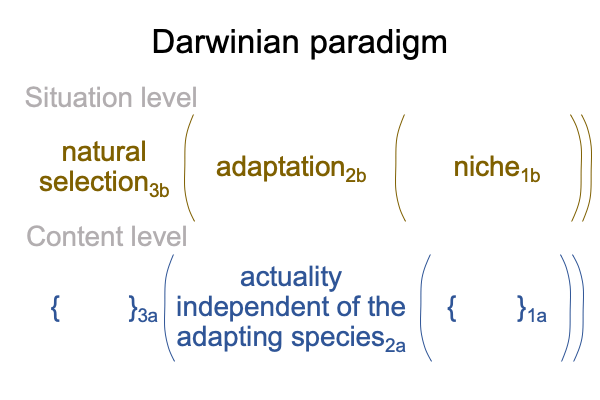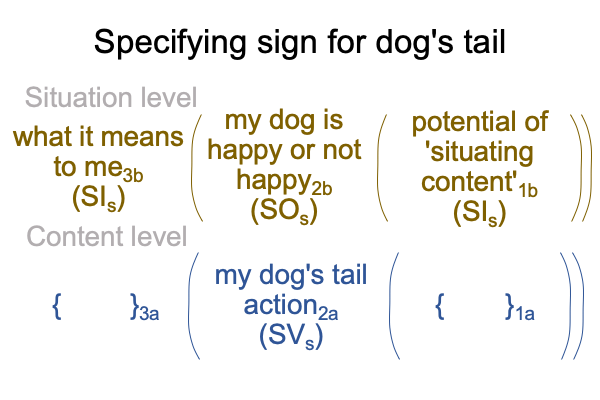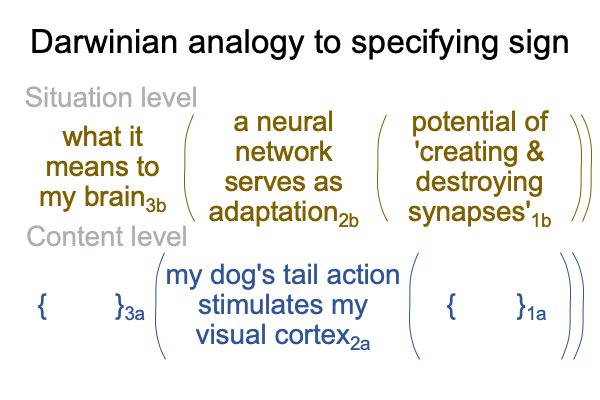0017 Evolution is the path that leads the reader from the earliest form of life, bacteria, to one of the West’s best musical designers, Johann Sebastian Bach.
Is that what Dennett claims?
If so, then the preceding blog offers an interesting comparison.
I wonder, can the specifying sign serve as an analogy for Darwin’s paradigm?
What about the other way around?
0018 Here is picture of the two-level interscope for the Darwinian paradigm.

Here is a picture of the two-level interscope containing the specificative sign of a dog’s tail action.

0019 Darwin’s paradigm and the specifying sign have a similar category-based structure.
So, may they serve as analogies for one another?
0020 If Darwin’s paradigm serves as a metaphor for the specifying sign, then my dog’s tail action2a is like an actuality independent of the adapting species2a. My dog’s tail action2a harbors a potential that may be exploited or avoided1b. Of course, the word, “niche”, seems a little awkward in this instance. A clever fellow, named Gibson, comes up with a good substitute. Gibson labels the potential with the term, “affordance1b“.
The dog’s tail2a provides an advantage to the human, that is, an “affordance1b“. The dog’s tail might also offer a disadvantage, which is also an “affordance”. Gibson’s term is ambiguous in this regard. Nevertheless, “affordance1b” suggests that the adapting species exploits the opportunity or avoids the danger.
0021 So, what on earth is the adapting species in this example?
It must belong to me, since my situation-level normal context, what the dog’s tail means to me3b, is like an episode of natural selection3b.
Dennett raises a very interesting option. Maybe, evolution is going on in my head.
Maybe, the neural networks in my head are products of Darwin’s paradigm working on neural synapses.
According to Darwin, natural selection3b is a mindless proclivity to survive (or not survive) in the face of an affordance. For neurons, “survival” concerns participation in a neural network that serves to exploit or avoid an affordance.
For example, neurons in the cerebellum coordinate signals for fine-tuned motions. They are in business as long as the appendage or musculature that they are involved with is present and working. Neurons in the neocortex tend to be more enterprising. These cells are busy creating new synapses with other neurons. They network, so to speak. They fish for business… er… affordances. The selection process is guided by… shall I say… the best of all possible affordances1b: an answer2b to the question of what the dog’s tail action2a means to me3b.
Yes, I want to be Candide, in this regard.
0022 This leaves the specifying sign-object2b (SOs) as analogous to an adaptation2b.
Isn’t that curious?
If Darwin’s paradigm serves as a metaphor for the specifying sign, then the inquirer may visualize a hypothesis concerning how the brain operates. The actuality independent of the adapting species2a is my dog’s tail action. The adaptation2b is a circuit built from synapses (along with their entrepreneurial neurons) that somehow conveys the mental perception that my dog is either happy or upset2b.
This particular instance of natural selection is a variation of Darwin’s paradigm, because synapses are entities that either survive or don’t survive and neocortical neurons are long-lived prospectors that make (or cut loose) synapses in order to stay in business. The synapses are selected for or against. The neurons breed synapses. The neurons select for synapses that participate in sign-processing networks.
0023 Here is a revised picture for a dog’s tail as a specifying sign.

0024 Perhaps, the analogy works, but the adapting species3b is not so clear. Is it the synapse, the neuron or the local network? Or maybe, it is all three, with the synapse similar to a member of a species, the neuron similar to a breeder of the species, and local networks serving as a motivation for why a neuron breeds synapses.
Plus, what is the affordance1b in this instance?
0025 On top of that, what about memes?
My dog’s tail action may be labeled a “meme“.
Dennett associates memes to affordances. And here, one affordance is clear. The meme survives because it satisfies a particular specifying sign. Perhaps, all that a researcher needs to do is look for specifying signs that have survived for a long time in order to formulate hypotheses on the ways that memes survive.
Does that sound like circular logic?
0026 To me, here is one affordance1b. If a dog’s tail-action is an index of its attitude, then that is an advantage to me, because it makes my dog’s behavior comprehensible.
With this adaptation2b at hand, er… in mind, Daisy, my dog, becomes reasonable, as long as she stays on her leash.
